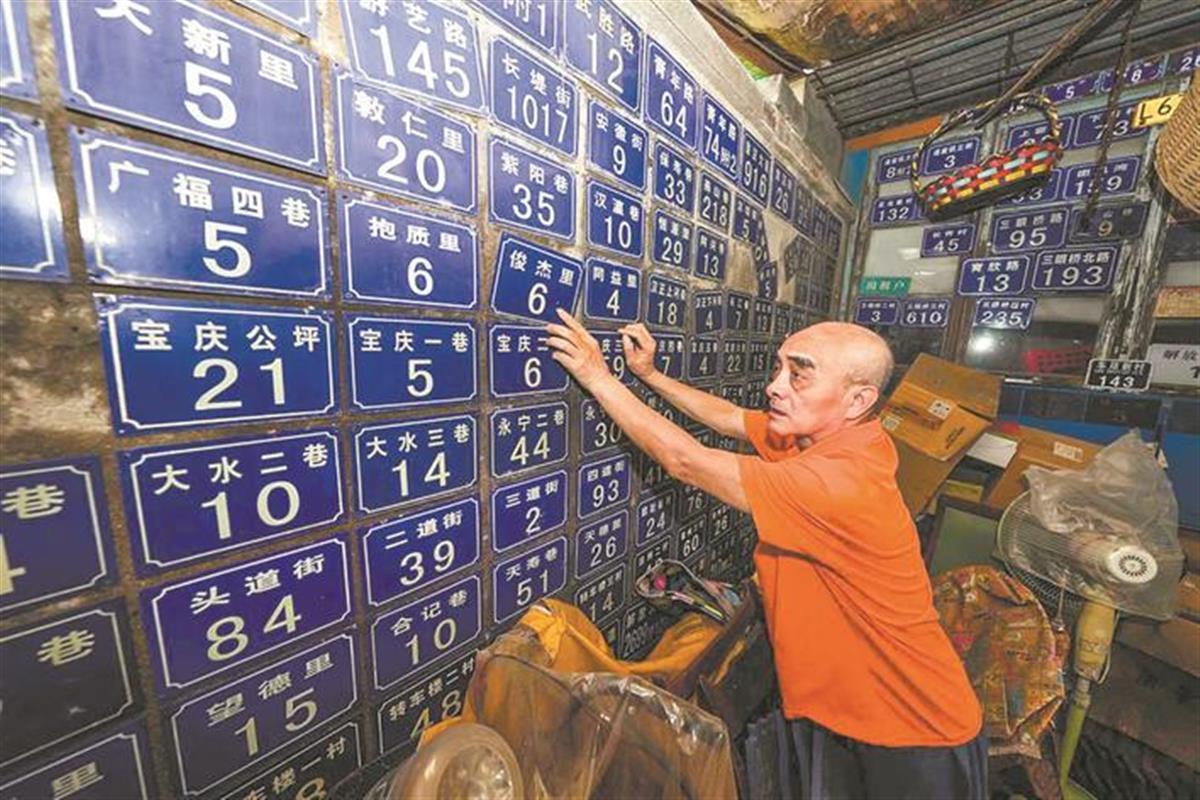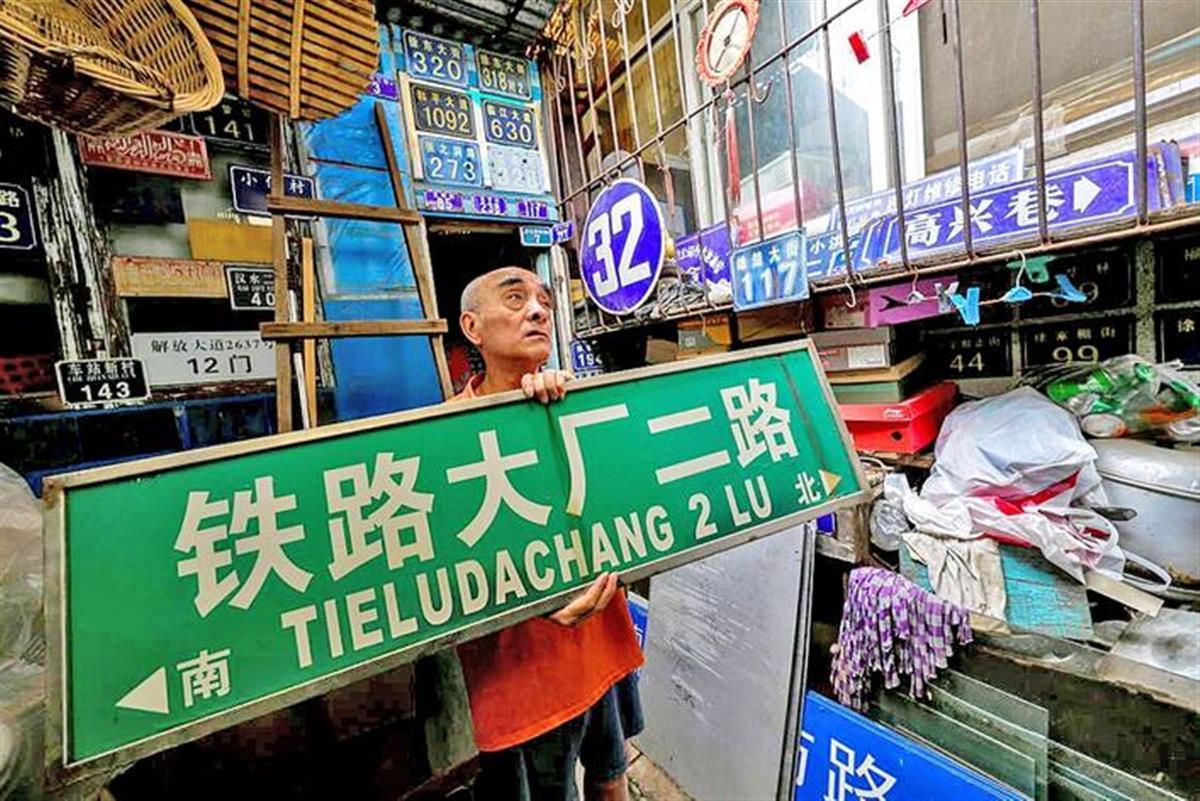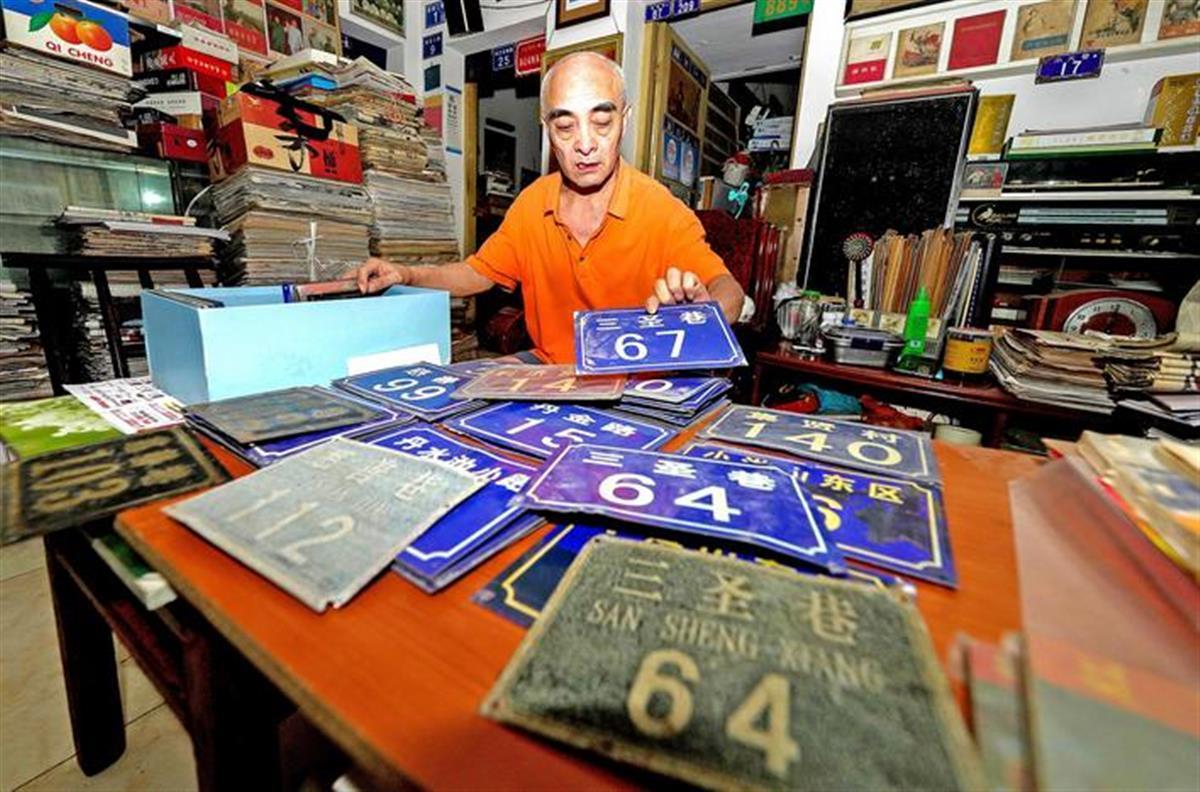“门牌爷爷”家中藏有“门牌博物馆”
Elderly man creates a secret at home “museum of door plates”
极目新闻记者 林楚晗
实习生 童诗涵 荣卓依
摄影记者 肖颢
翻译:宋婷 丁颖 卫拉(湖北大学)
Jimu News Reporter: Lin Chuhan
Jimu NewsInterns: Tong Shihan, Rong Zhuoyi
Jimu News Photographer: Xiao Hao
Translators:Song Ting, Ding Ying, Lisa M. K(Hubei University)
门牌见证了城市的起源、发展和变迁,也承载着市民的生活痕迹和情感。随着现代社会日新月异,城市的面貌不断变化,旧楼拆除新建,老街改造更新,许多小时候生活的地方逐渐消失在时代潮流中,只能留在人们的记忆中。于是,建筑上的旧门牌,就成了留存记忆的载体。
The doorplates witness the origin, development and change of a city, and also carry the life traces and emotion of its citizens. With the rapid changesof modern society, ourcityscapes are equally ever-changing. Old buildings are demolished andrebuilt, and so are old streets. Many places fromour childhoodshavetoogradually disappeared in the trendsof ourtimes, becoming mere nostalgic memories.Naturally, the old door plates ofbuildings became an embodiment of nostalgia.
在武汉,有这么一位爹爹,花费11年的时间,收集了二千多块武汉的旧门牌,在家中建了一个“门牌博物馆”。他说,每一个门牌都承载着武汉历史的DNA,记录着这座城市的文化记忆。
In Wuhan, an elderlyman has spent 11 years collecting over2,000 pieces of Wuhan’s old doorplates and built an at-home“door-plate museum”. He said that every door plate is a capsule of Wuhan’s historical DNAand a record of its culture.

吴正祥向记者展示他收藏的门牌(Wu Zhengxiang is showing the door plates he collected to the reporter)
11年收藏2000多块武汉门牌
Amassing Over 2000 Antique Doorplates in 11 Years
6月25日,极目新闻记者一走进“门牌爷爷”吴正祥家中,就被屋子里随处可见的门牌所震撼,只见被他收藏的门牌塞得满满当当,门牌像墙纸一样贴满所有墙面。青年大道12-3,紫阳路261……这些消失的武汉路名和地名,挂在他屋里的墙上,仿佛时光密钥一般能唤醒那些沉睡在脑海深处逝去的岁月。
On June 25, upon entering Wu Zhengxiang’s home, the reporterwas shocked by the sheer amount of doorplatesinside, which like wallpaper,coveredevery inch of the walls. Youth Avenue 12-3, Ziyang Road 261, theseand other doorplates are the remnants ofroad and landmarknames in Wuhanthat have disappeared. Hanging on the walls of his house, they are capable of awakening memories from times passed lying deep.
在他的后院,他专门布满了一整面“路牌墙”,颇为震撼。
In his backyard, he specially decoratedawall with street nameplates, and the finished look is quite impressive.
今年66岁的吴正祥是地道的“老汉口”,家住武汉市江岸区,是武汉铁塔厂退休工人。早在清末,他的曾祖父就迁来武汉,住在花楼街小董家巷,此后几代人从未离开,直到后来花楼街开始拆迁。
Wu Zhengxiang, 66 years old this year, is a true“Hankou local”.He lives in Jiang'an District of Wuhan and is a retired worker of the Wuhan Iron Tower Factory.As early as the late Qing Dynasty, his great-grandfather moved to Wuhan and settled down in the Xiaodong Lane, Hualou Street. Since then the followinggenerations had never left until the Hualou Street began to be demolished.
吴爹爹收集门牌的爱好持续了11年。谈起收集门牌的起源,吴爹爹告诉记者,2010年的某一天,他突然想去自己小时候生活过的花楼街转转,却发现那里已经被拆除,自家以前的门牌早已不见踪影,他怅然若失。正是这次经历让吴爹爹动了收藏门牌的念头,“我就想着有门牌在,至少证明以前的建筑和家曾经存在过。”
Mr.Wu has been collecting doorplates for 11 years. When it comes tothe origin of his hobby, hetold the reporter that one day in 2010, he suddenly wanted to revisit the Hualou Street where he had spent his childhood. To his dismay, he found it demolished, and thedoorplate ofhis own home was nowhere to be found. This experience left him a sense of loss. It was this experience that inspired Wuto start collecting doorplates. “I just thought having the doorplateswould at least prove that the old buildings and homes once existed.”
保寿巷33号,是吴爹爹收集的第一块门牌,被他挂在后院木质纱门的门框上,他特意记下了这块门牌的收集时间,2013年4月。吴爹爹指着这块门牌告诉记者,保寿巷因古桥保寿硚而得名,位于汉正街。小时候,他常常跟着挑着担子卖些日用百货的父母走街串巷,针线、小锁、香纸、香水,都是邻里街坊的日常所需。母亲在前面叫卖,他便跟着在各个街巷里穿梭玩耍,因此对于汉口这一带的大街小巷,他再熟悉不过,“没有不知道的路。”吴爹爹笑着说,“保寿硚、延寿桥、长寿桥、万寿桥,这些门牌听起来就很吉利。”
Number 33, Baoshou Lane, wasthe first ofMr.Wu’s finds. He hung it on the wooden screen door frame in his backyard and made a note of the collection date: April 2013. Pointing to it, Wutold the reporter that Baoshou Lane got its name from the ancient bridge, Baoshou Qiao, located in theHanzheng Street. When he was young, he often accompaniedhis parents who lagged an assortment of households itemsto sell inthe streets and alleyslike needles, small locks, incense paper, and perfume, all of which were in high demand in the neighborhood. While his mother was busy hawking ahead, he followed her playing and exploringnearby streets and alleys.With time, he became familiar with the streets and alleys around Hankou. “There's no road I don't know,” Mr.Wulaughedand added,“Baoshou Qiao, Yanshou Qiao, Changshou Qiao, and Wanshou Qiao, they allsound very auspicious.”
一块、二块、三块……不知不觉,11年,吴爹爹已收集了2000余块门牌。说起这些门牌,他头头是道,“你看这块写着三民路66号的门牌就是德华酒楼,德华楼最有名的是年糕。”“西城壕就是武昌那边一个墙底下的壕沟。”“这个转车楼门牌,是因为当年这里有个转车盘,当时是蒸汽火车,只有一个车头,不能双向开,就在这里建了个转车盘,专供火车掉头用。现在转车盘不在了,但有这块门牌在,那段历史就在,老武汉人就能通过这块门牌回忆那段历史,讲给后人听。”
One plate, two plates, three plates… Without paying much thought, overthe past 11 years, Wucollected more than 2,000doorplates. When askedabout these plates, he talks of each in intricate detail“Look at this one. It is engraved with Number 66 Sanmin Road,which is theDehua Restaurantand they are famous for their rice cake.”“Xicheng Hao used to be a moat under a wall in Wuchang.” “This plate wasused to mark a railway turntable built here forthe steam trains. At the time, steam locomotivescould only run in one direction, so a turntable wasbuilt here to spin locomotives the other direction. While theturntable is gone now, with this plate, that period of the history remains. Old Wuhan residents can recall that time in history through this plate and pass it down to the future generations.”
对于吴爹爹来说,这些门牌就像历史的碎片,随便拿起一块,他都有滔滔不绝讲不完的故事。他说:“每当我看到这些门牌,就能想起那条曾经有过、走过的街道。”
For Mr.Wu, these doorplates are fragments of the history that remind him a multitude of stories. He said, “the past streets come into my mind every time I see these doorplates.”
吴正祥向记者展示他收藏的门牌(Wu Zhengxiang is showing the door plates he collected to the reporter)
“门牌是家和建筑的坐标,藏着武汉的文化DNA”
Doorplates like Landmarks Encapsulating the Cultural DNA of Wuhan
2000多块门牌,吴爹爹是怎么一块块收集来的呢?他告诉记者,为了收集这些门牌,他跑遍了武汉三镇的拆迁工地。那些即将随着残垣瓦砾隐入尘烟的门牌,在挖掘机到来之前,被他“抢救”了出来。
How did Wu collect all 2,000 door plates? Mr.Wu explained that he has scoured every demolition site of the threetowns of Wuhan (Note: Divided by the Yangtze river, the ‘Three Towns of Wuhan’ refers toHankou and Hanyang on the west bank, and Wuchang on the east) to rescue the discarded doorplates from the excavators.
每次去收集门牌的时候,吴爹爹都会带上工具,先跟门牌和建筑合个影,然后小心翼翼地把门牌上的螺丝拧开并取下。起初,他去撬门牌还不被人理解,吴爹爹说他也不在乎别人的看法,因为在他看来,他是通过收集,让这些“无家可归”的门牌有一个新的安身之所。
Wutakes his tools everytime he collects the doorplates. He begins by takinga photo with the doorplates and the buildings before carefully unscrewingit. Initially, he was misunderstood by others, but he did not let it bother him.From his point of view, he was finding a new home for these doorplates through his efforts.
吴爹爹向记者介绍,高兴巷是他收集的年代最久远的门牌,1972年的,搪瓷材质。后来门牌的材质就变为铝材、铜材、塑料材……门牌材质的变化演绎着城市的发展。
Mr.Wuintroduced that his oldest collection was an porcelain enamel doorplate from the Gaoxing Alley in 1972. The materials of his later collections include aluminum, copper, plastics and so on. This change reflects the development of Wuhan.
采访中,吴爹爹告诉记者,不少武汉市民熟悉的汉口里的门牌墙上挂满的门牌,大部分是他捐赠的。“当时我也挺舍不得的,但是想着它们挂到墙上,可以让更多人了解武汉的历史,我就同意了。”如今这面墙成了汉口里一道独特的风景线,是不少游客游汉口的必打卡点。
Mr.Wumentioned that most of the doorplates atthe locally acclaimed doorplate wall in Hankouliare donated by him. “I decided to donate them to showcase the history of Wuhan to more visitors, even though I loved them so much.”Currently, the doorplate wall has become a must-go place for those visiting Hankou.
未来打算如何处理收集的这些门牌呢?当记者问到这个问题时,吴爹爹表示以后会把这些门牌捐赠给相关部门。
When it comes to the future of his collections, Mr.Wu expressed that he will donate them to relevant departments.
“门牌是家和建筑的坐标,藏着武汉的文化DNA。”在吴爹爹看来,收集门牌常常能让他真切地触摸到,那些消失的老宅子真实地存在过,他们是武汉历史文化的真实见证。
“The doorplates are symbols of our homes and buildings, encapsulating the cultural DNA of Wuhan.”For Mr.Wu, his collections are physical proofthat the now disappeared homes had indeed once existed.These doorplates are the true witnessesof Wuhan’s history and culture.
吴正祥向记者展示他收藏的门牌(Wu Zhengxiang is showing the door plates he collected to the reporter)
(来源:极目新闻)
更多精彩资讯请在应用市场下载“极目新闻”客户端,未经授权请勿转载,欢迎提供新闻线索,一经采纳即付报酬。24小时报料热线027-86777777。



